Is There a Gospel in the Stars?
Message in the Stars
Star Names
The Zodiac
Virgo
Libra
Scorpius
Sagittarius
Capricorn
Aquarius
Pisces
Aries
Taurus
Gemini
Cancer
Leo
Other constellations (incomplete)
Message in the Stars:
There is a major question people in general ask of Christians: if salvation is only through Jesus, what about those people who lived before, or who never heard of him in other places? Do they all go to hell? This is an honest question, and one that deserves an answer.
Our first clue comes from Peter’s second letter:
2 Peter 3:9 – “The Lord is not slow in keeping his promise, as some understand slowness. He is patient with you, not wanting anyone to perish, but everyone to come to repentance.”
God says he is not willing ONE should perish.
Romans 1 indicates something interesting:
“The wrath of God is being revealed from heaven against all the godlessness and wickedness of men who suppress the truth by their wickedness, since what may be known about God is plain to them, because God has made it plain to them. For since the creation of the world, God’s invisible qualities – his eternal power and divine nature – have been clearly seen, being understood from what has been made, so that men are without excuse.”
How has God made his eternal power and divine nature plain? Some people point to the beauty of creation, some to the size of the universe, some to the complexity of life – all these are fine, but this may not be what the Bible is talking about.
Later on in Romans, Paul seems to be following through on this. In Romans 10, we read something very familiar, but which is answered by Paul in a way not many people pay much attention to:
“As Scripture says, “Anyone who believes in him will never be put to shame.” For there is no difference between Jew and Gentile—the same Lord is Lord of all and richly blesses all who call on him, for, 'Everyone who calls on the name of the Lord will be saved.'
How, then, can they call on the one they have not believed in? And how can they believe in the one of whom they have not heard? And how can they hear without someone preaching to them? And how can anyone preach unless they are sent? As it is written: 'How beautiful are the feet of those who bring good news!'
But not all the Israelites accepted the good news. For Isaiah says, 'Lord, who has believed our message?' Consequently, faith comes from hearing the message, and the message is heard through the word about Christ. But I ask: Did they not hear? Of course they did:
'Their voice has gone out into all the earth,
their words to the ends of the world.'”
First, “how beautiful are the feet of those who bring good news.” Why, if everyone has access to knowledge about the Lord’s nature, do they need good news? A friend of ours who is a pastor tells of an associate of his who was a missionary in Japan. After one of his presentations, an old lady came up to him and said, “I am so glad I was here tonight. You see, I’ve known this story since I was a child. It’s all written in the names of the stars, but I never knew HIS name, Jesus, before.”
Let’s go back to the verse in Romans 10. Paul asks, “Did they not hear? Of course they did!” And then he quotes from Psalm 19.
Let’s look at the opening to Psalm 19:
The heavens declare the glory of God;
the skies proclaim the work of his hands.
Day after day they pour forth speech;
night after night they reveal knowledge.
They have no speech, they use no words;
no sound is heard from them.
Yet their voice goes out into all the earth,
their words to the ends of the world.
That’s the NIV. Here is the old King James:
The heavens declare the glory of God; and the firmament sheweth his handywork.
Day unto day uttereth speech, and night unto night sheweth knowledge.
There is no speech nor language, where their voice is not heard.
Their line is gone out through all the earth, and their words to the end of the world.
In the ancient Alexandrian LXX, it reads:
The heavens declare the glory of God;
And the firmament proclaims the work of his hands.
Day unto day utters speech,
And night to night proclaims knowledge.
There are no speeches or words,
Of which their voices are not heard.
Their voice is gone out into all the earth,
And their words to the ends of the world.
The NIV does lose a little in the translation here: both of the older texts emphasize that “There is no speech nor language where their voice is not heard."
So what is it that utters, or pours forth speech; which voice goes out to all the world? Whatever it is, it shows the glory of God.
Is the glory of God twinkling stars? Not according to Hebrews 1. The opening verses are very important in this regard:
“In the past, God spoke to our forefathers through the prophets at many times and in various ways, but in these last days he has spoken to us by his Son, whom he appointed heir of all things, and through whom he made the universe. The Son is the radiance of God’s glory and the exact representation of his being, sustaining all things by his powerful word.”
So the glory of God is not just twinkling stars, but Christ Himself. If the heavens declare the glory of God, then they are saying something about Christ. Now, consider the opening of Hebrews: “In the past, God spoke to our forefathers through the prophets at many times and in various ways.”
Therefore, if we allow Bible to explain Bible, there is something about the heavens which declares Christ. Look at the fourth line of Psalm 19: “night after night they display knowledge.” What knowledge? Whatever it was, Paul seems to indicate it had something to do with everyone hearing the word of Christ.
There is another indication, also which is explained later by Paul, about a message in the stars. It comes very early in the Bible, in Genesis 15. Abraham has no children. Both before the time described by this passage and after, God has promised Abraham many offspring:
Genesis 13:16 – “I will make your offspring like the dust of the earth, so that if anyone could count the dust, then your offspring could be counted.”
Genesis 17:5-6 – “No longer will you be called Abram; your name will be Abraham, for I have made you a father of many nations. I will make you very fruitful; I will make nations of you, and kings will come from you.”
Thus, God’s promise to Abraham regarding multiple descendants has been established before Genesis 15, and will be reiterated, very clearly, by God. But in Genesis 15, there is another incident which Paul later explains.
First, the NIV (and we do like the NIV, but there is a mistake here, again)
After this, the word of the Lord came to Abram in a vision:
“Do not be afraid, Abram.
I am your shield,
your very great reward.”
But Abram said, “Sovereign Lord, what can you give me since I remain childless and the one who will inherit my estate is Eliezer of Damascus?” And Abram said, “You have given me no children; so a servant in my household will be my heir.”
Then the word of the Lord came to him: “This man will not be your heir, but a son who is your own flesh and blood will be your heir.” He took him outside and said, “Look up at the sky and count the stars—if indeed you can count them.” Then he said to him, “So shall your offspring be.”
Abram believed the Lord, and he credited it to him as righteousness.
Now the old King James:
After these things the word of the Lord came unto Abram in a vision, saying, Fear not, Abram: I am thy shield, and thy exceeding great reward.
And Abram said, Lord God, what wilt thou give me, seeing I go childless, and the steward of my house is this Eliezer of Damascus?
And Abram said, Behold, to me thou hast given no seed: and, lo, one born in my house is mine heir.
And, behold, the word of the Lord came unto him, saying, This shall not be thine heir; but he that shall come forth out of thine own bowels shall be thine heir.
And he brought him forth abroad, and said, Look now toward heaven, and tell the stars, if thou be able to number them: and he said unto him, So shall thy seed be.
And he believed in the Lord; and he counted it to him for righteousness.
There is a word which needs to be examined here as it comes across in the English. It is used when the LORD tells Abram to ‘count’ the stars. The word in the Greek is 'arithmos,' which is 'something as reckoned up,' coming from 'airo,' meaning 'to lift, to take up, to take away.' The meaning of 'arithmos,' is much wider than 'count' and can mean 'enumerate' or 'reckon.' In the LXX, the word translated 'number,' from 'if you can number them,' has the prefix, 'ek' or 'ex' means 'among, because of, between, from, by means of, etc.' The word itself then is ekarithmos (or exarithmos).
In the Hebrew, the word which becomes 'count' in English is 'caphar,' which means 'to score, to mark as a tally, to record, to inscribe, to recount, to celebrate or enumerate. Also to talk or to tell out.' It comes from a root meaning 'a book' or 'a scroll.'
God did not tell Abraham to count the stars. That is not the translation of the word used in the Hebrew. God told him to ‘recount’ or ‘tell’ the stars. There was a story there that God wanted Abraham to take note of. And there was something about this story that Abraham believed and it was counted to him as righteousness.
We know that our righteousness is in Christ. That has never changed. Noah was the only righteous man in his time – the belief in a coming Messiah had vanished except for him. Job knew about it after the Flood: “I know that my Redeemer lives, and that in the end he will stand upon the earth. And after my skin has been destroyed, yet in my flesh will I see God; I myself will see him with my own eyes – I and not another. How my heart yearns within me.”
When God told Abraham ‘so shall your offspring/seed be,’ was God saying the Messiah would be Abraham’s offspring? Was that what Abraham was to ‘tell’ in the stars?
Paul explains a bit about this incident in Galatians 3:16:
The promises were spoken to Abraham and to his seed. The Scripture does not say ‘and to seeds,’ meaning many people, but ‘and to your seed,’ meaning one person, who is Christ.
The King James and other translations we read today do not use the word 'seed.' But it is in the ancient Alexandrian LXX, translated almost 300 years before Christ. That is the version Paul and the Apostles would have known. And here Paull is clarifying that God told Abraham his SEED was being referred to, in the singular, not the Hebrew plural, which would translate 'seeds.'
If so, we should see some other indication of this belief on Abraham’s part, and we do. He very possibly thought Isaac was the promised Messiah, the child of the Promise. First of all, Abraham did receive a very specific promise that he would have a son at a particular time (Genesis 17:15-16, 18:10). Then, in Genesis 22, we read what appears to be the profoundly disturbing account of God commanding Abraham to sacrifice his son Isaac.
What is interesting is that Abraham does not plead for the life of his son. He does not question God’s command. Why not? Did Abraham know the Messiah had to be sacrificed and then would be resurrected? If so, did he believe his son was the sacrifice? What we read is that Abraham obeyed “early the next morning.” They traveled for three days with their servants to make this special sacrifice. When they arrived, Abraham says this to the servants who accompanied them: “Stay here with the donkey while I and the boy go over there. We will worship and then we will come back to you.”
WE will come back to you. Abraham indicated they were both coming back.
Was Abraham aware of the reality of a Resurrection of the Messiah? Does he think this is what will happen to Isaac? We don’t know, but not only are his words at the base of the mount interesting, but God’s interruption of the sacrifice is also interesting when God says that He Himself will provide the Lamb. THE lamb. One. That is the Messiah. Abraham would be the ancestor of Christ, but not His direct father. The Lord needed to make that clear.
The old Japanese woman indicated the story was in the stars. Paul refers directly to the Psalm which says the heavens pour forth knowledge NIGHT after NIGHT – that’s when we see the stars. Abraham was told to “recount” or “tell” the stars and he believed and it was credited to him as righteousness. Paul says the reference there is to Christ.
So let’s look at the stars. We read in the Bible that man named the animals. But we also read in the Bible that God named the stars.
“Lift up your eyes and look to the heavens:
Who created all these?
He who brings out the starry host one by one,
And calls them each by name.”
God does nothing without a purpose.
Today the idea of looking to the stars, if you are not dealing with the science of astronomy, is called astrology. The word itself means “the word about the stars.” But in our culture it is no longer that at all. It has become a reflection of our attempt to be as God, actually, and we think the astronomical signs are about US. This is entirely perverted. But you can’t have a perversion unless something was right and straight and true to begin with.
How are we supposed to know the meaning? How did anyone before know the meaning? It was the same as reading. You had to be taught. We cannot look up into the sky and say, “Oh, look, there’s a lion!” Just like reading a book, it is something that has to be learned.
The original intent of star names and constellation names was what bound astronomy and astrology together in the past. For example, if the ‘star’ the wise men were watching for at the time of Jesus’ birth was the big shining thing we see on Christmas cards, everyone would have seen it. But they didn’t. The Magoi were watching for something the trained eyes of astronomers would see. The fact that it was something unique is recorded by other astronomers in the Roman Empire who claimed the heavens were applauding Augustus Caesar.
In Genesis 1:14, we are told the heavenly bodies are for signs, seasons, days and years. Days and years we understand clearly. The earth rotating in its axis produces a day, and its revolving around the sun gives us a year. What about the reference to seasons? This would not be a reference to summer, winter, spring or fall at first, but simply the ‘areas of time’ as the year progressed. In relation to the heavenly bodies, that would indicate the signs of the zodiac, which would later translate into months.
The word ‘zodiac’ is not a bad word in itself! It comes from ‘zoad,’ meaning ‘path’ or ‘way. It refers to the way the sun appears to pass through the various constellations during the year. The diagram below shows the way the zodiac looks today, and it can be seen that it is a bit ‘off’ from what we associate as signs for the various months. This is due to something called the ‘precession of the equinoxes.’
But the heavenly bodies are also for signs. What is a sign? When you see one that says “road closed ahead” or “San Francisco 300 miles” these signs are giving you information. Psalm 19 says the skies pour fourth KNOWLEDGE night after night. What is the information there the Bible is referring to?
The constellations have been known from antiquity and they have been basically unchanged. Taurus and Ursa Major, for example, appear in cave art. The names of the stars have retained their meaning in various languages. For instance, the constellation “Virgo,” meaning “virgin” is referred to as "Bethulah" in Hebrew, "Parthenos" in Greek, "Kanya" in Hindi – all of which mean “virgin.” This indicates a prior knowledge of the names of the stars and constellations prior to the language confusion at Babel. This knowledge may well have come down from Noah and even from Adam. The star and constellation names have been handed down from antiquity. We can see stars being referred to on cave walls.
Remember our beginning question? If salvation is only through Jesus, what about those people who lived before, or who never heard of him in other places? Do they all go to hell?
The simple answer is that the knowledge of God’s promise to rescue people Himself has been known through time in all cultures. To believe in that promise was to believe in God’s Word. And the Word was and is Jesus Christ. The trust that God would keep His Word was salvation for the believers before Christ just as the trust that God has kept His Word through Jesus Christ is salvation for believers today.
In the Bible, we are told Adam named the large land animals and birds, but God named the stars. When we look at the ancient names, some interesting things emerge. However, because of the perversion of astrology today, many Christians are afraid to take a look at these names and see if God had a purpose in what He named them. It is wise to remember, however, that names in the past always meant something. Today we choose names for our children because they sound pretty, or we are perhaps honoring a relative or friend. But the ancients used names that meant something. For instance, David means 'hero, commander, prince.' Benjamin means 'son of the right hand.' This list is, for all intents and purposes, endless. So it should not surprise us when we find that the original names of the stars had meanings. Finding the original meanings is not always easy, and can take a lot of time and research, going back into different languages, root words, etc. But for enough of the stars it is possible, and when this is done, something quite remarkable emerges.
The following is an exploration of this subject, astronomically, historically, and biblically. It is NOT astrology and we totally repudiate the concept of astrology as it is known today. Today, astrology says a man can tell something about himself from the stars. That is nonsense. In fact, it may go beyond nonsense and into demonic. Their original purpose, as we will see (and which is also stated in the Bible) was to tell us something about God and His plan for the world.
Please recall, “In the past God spoke to our forefathers through the prophets at many times and in various ways, but in these last days he has spoken to us by his Son, whom he appointed heir of all things, and through whom he made the universe.” (Hebrews 1:1-2)
So let’s take a look at what we find when we look into this.
Star Names
The constellations themselves have been known from antiquity. Their identities have remained basically unchanged, although a few of the ancient large constellations have been divided up by modern astronomers into smaller constellations. But for many, the identities remain. For instance, the constellations of Taurus (the bull) and Orion appear in cave art dating back to 3000-2900 B.C.
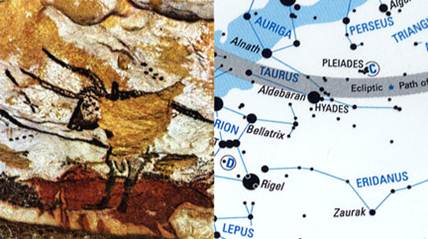
For those who do not think there is any reference to the stars in the picture of the bull on the left, please note the series of dots above his back. These are the Pleiades. The dots under the eye of the bull are the Hyades, and the four dots to the left of the bull's nose are the stars in Orion's belt. The is actually no avoiding this identification.
The book of Job is the earliest completed book of the Old Testament, written about 2900 B.C. In Job 38:31-32, the Pleiades and Orion are both mentioned by name.
Around 2700 - 2500 BC, the Sumerians recorded the existence of a “Tablet of the stars of the heavens.” as shown below (courtesy of Wikipedia)
Sumerian Gudea Cylinder A (2300 BC) has clear mention of many star groups or signs
Mesopotamian tablets dating about 1800 B.C. record both star names and the observations of planetary movements.
Dating about 1400 B.C. are Chinese oracle bones which list the Chinese star names.
Babylonian and Chaldean tablets dating from 800 - 600 B.C. record the zodiac signs by name.
Discoveries dating material from 2000 years ago indicate a knowledge of the zodiac in Arabia.
Today, because the astronomical names are now fixed by convention, it is very difficult to find some original names and meanings. Some appear to be lost for good. Star and constellation names were fixed in a process lasting from 1603 to 1930. So to find some of the meanings, if they are to be found, we must search back into the sixteenth century and before.
In 1603, Bayer started the process of standardization by designating stars in the various constellations by letters of the Greek alphabet instead of by names. When he ran out of Greek letters, he started using Roman letters. So the brightest star in a constellation would be ‘alpha,’ and the next brightest ‘beta,’ and so on. This process has been followed ever since. In 1725 Flamsteed published his catalogue of stars. In it the fainter ones were designated by number if no Greek or Roman letter had been given previously. In 1801, Bode published star maps with boundaries for each constellation. This was the first time these boundaries had been designated. In 1922 the International Astronomical Union (IAU) held their first meeting. It was at this time certain star names were assigned and considered to be standardized. These names were chosen from various languages (Babylonian, Hebrew, Chaldean, Greek, Roman, and Arab and others) according to what they felt was appropriate, or in most common use, at the time. Most of the names chosen retained either the original meaning, or close to it, in the language chosen. Some, however, did not.
In 1930 the process was completed when the IAU standardized the constellation boundaries and names. 88 constellations were named, which included the modern ones formed by splitting some of the older 48 constellaitons and by adding some others in the Southern Hemisphere.
We do have some cross-checks on the more ancient names, however. As early as 150 A.D., Ptolemy in his Almagest listed 48 constellations and 1022 star names. His accurate description of the position of each constellation and star he mentioned make it easier to trace today. (ref: R.C. Taliaferro, The Almagest of Claudius Ptolemy, 1952; also G.J. Toomer, Ptolemy’s Almagest, Duckworth & Co., London, 1984).
We can even go back a little further. Hipparchus, in 130 B.C also noted some of the stars and their names. He mentioned that the names and constellation figures were of “unsearchable antiquity.” Going back even further, to Eudoxus (403-350 B.C.) in his Phainomena, also recorded a number of star names. In 1822, Jamison noted some of these ancient names in his Celestial Atlas.
Some of the confusion also started early, however. In 270 B.C., Aratus of Tarsus wrote the Diosemeia, one long poem about the constellations and the stars in them. In this poem he incorporated a number of mythological elements which have even come over into our time. For example, Alpha in Ursa Major is called Dubhe in Hebrew or Dubah (Arabic) both of which mean fold or flock. The word ‘fold’ implies rest and security and strength as a sheep would find in a sheep-fold. The word is used this way in Deuteronomy 33:25 to describe our strength or security from the Lord. It must now be noted that Dubhe or Dubah has been confused by Aratus with the Hebrew ‘dohv’ or Arabic ‘dub’or Persian ‘deeb’ all of which mean bear. They are pronounced almost the same way and in some concordances the words are consecutive. However, they have vastly different meanings. Because of this linguistic mix-up, we now have the Greater and Lesser Bear instead of the Greater and Lesser flocks or folds.
Aratus’ poem was translated into Latin by Cicero and into English about 1880 by E. Poste and J. Lamb, so many of the mythologies involved in these names persist.
Today, thanks to the internet, we have access to some of the dictionaries of some various ancient languages. Thus, we can go back in time much more accurately than has been done before in tracing the earliest names and meanings of a number of the stars and constellations.
The Zodiac
Aside from cold and warmth, new flowers and harvest, the time of year is also seen by which constellations are where in the sky as seen from earth in its orbit around the sun. Because of the earth’s orbit around the sun, the background of the stars and constellations in which the sun appears changes. This is called the ‘zodiac.’ The word itself comes from ‘zoad,’ the Greek word for a way, a path, a step, or circuit. In Sanscrit the word is sodi.

The specific twelve constellations we recognize today as the zodiac is referred to as the Mazzaroth in Hebrew. We find this word used in Job 38:32, which means the word was in use extraordinarily early, as Job is probably the earliest completed book of the Bible. In Job 26:13, Job says God formed the constellation figures. The ‘fleeing serpent’ mentioned there is Hydra, a constellation which takes seven hours to pass overhead because of its length (it is the longest constellation in the sky).
So there are some indications in the Bible that there is something going on ‘up there’ in the sky that we no longer are aware of, but that the people generations ago knew about. Let’s see if we can find out anything about this possibility. If what seems to be indicated is true, then we can see the absolute truth in Paul’s words that no one, no matter when or where they lived, had an excuse; before Christ’s incarnation all people would still have had access to the knowledge that not only would God provide the Messiah, the Savior, the Redeemer for all men, but that He Himself was that Savior.
If Psalm 19 is correct, then we should be able to find something about this in other cultures as well. Actually, one of the answers to this is one of the main tourist attractions in Egypt: the Sphinx.
The famous sphinx, the giant lion with a woman’s head, points exactly due east. It is so exact it cannot be an accident. The name ‘sphinx’ itself comes from the Greek ‘sphiggo,’ meaning ‘bind closely together. On tomb ceilings in Karnak the zodiac is depicted. This is also true at Dendera on the tomb ceilings there. In both places are pictures of the sphinx, placed at the end of the constellation Virgo and the beginning of Leo, with the head looking to Virgo and the tail in Leo.

In addition, at the time the Sphinx was carved, about the time of the First Intermediate Period, the axis tilt of the earth and the precession of the equinoxes meant that at that time of the spring equinox, as the sun was rising, the sphinx was pointed directly at the division between Virgo and Leo.
This was evidently important. The tomb ceilings tell us to start at Virgo. Let’s do that and look at the names of the stars and constellations, going as far back as we can where the names are concerned. Let’s see what we find. Some associated star groups and constellations will be discussed along with each of the zodiac constellations.
VIRGO and Coma
It is necessary to keep in mind that the 'stick figures' which connect the stars and the classical drawings which add so much detail can be quite different, as the various cultures choose to add or subtract various parts. Some of the classical drawings will be shown below, but the 'stick figures' are what actually show how the stars in each group are connected.
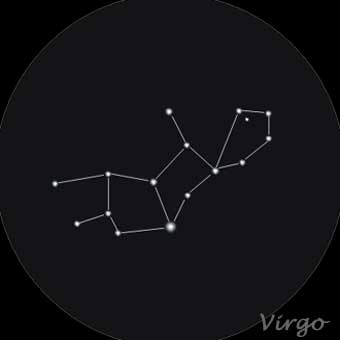
The alpha star is listed above as Spica (its Roman name). Hebrew name: Zerah. Meaning: ‘seed in Hebrew,’ ‘seed cluster’ in Latin.
The beta star (Beta Virginis, β ) is to the far right. Hebrew name: Zavijaveh or Zavijahveh which is a form of Tsebijahweh or Tsebiyahweh. Tsebi means “beautiful” or “desirable” and JHWH or YHWH is the tetragrammaton, the name of God to the Israelites. Therefore this star name means the “beautiful LORD.”
The gamma star (Gamma Virginis, γ ) is in the middle of the bottom of the constellation. The star Gamma has the name Porrima which was the Roman goddess of childbirth. It seems that this name has been substituted for an earlier name, and, indeed, some old star maps show this star (Gamma) as being called Al Tzemech instead of it being an alternative name for Alpha. In Hebrew, the word Tzemech means “Branch”
Another named star in Virgo is the Epsilon star (Epsilon Virginis ε ), the ‘topmost’ star in the figure above. Commonly called Vindemiatrix, it can be shown that this name originated with the poem “Phainomena” by Aratus and literally means “grape-gatherer”. R.H. Allen points out that in ancient times, before Aratus, it was called Al Muredin or Al Muridin, which in Arabic means “The One Sent Forth” or “The Sent One” In Chinese, this star was called Tsze Tseang “The Second General”
The Hebrew word ‘Zerah’ (the alpha star) is the word used to describe Messiah to Adam and Eve in Genesis 3:15 and to Abraham in Genesis 15:5. This latter reference is particularly interesting as Abraham had just been listing off the stars by name, and God said to him “So shall your Seed be”. Rabbi Paul, the Apostle, said in Galatians 3:16 that this “Seed” promised to Abraham was Messiah Himself. This was in line with the historic understanding of the meaning of the conversation between God and Abraham: the seed, “zerah” was a direct reference to the coming Messiah.
This understanding points to the fact that Messiah was to come as the “Seed of the Virgin.” This prophecy had both a general and specific application. In a general sense, the Virgin was a representation of Israel. We can see this in God’s comment through the prophet Isaiah to King Hezekiah of Israel about Sennacherib, King of Assyria, who had just been humiliated at Jerusalem. God said “The Virgin, the daughter of Zion, has despised you and laughed you to scorn.” The virgin daughter of Zion is the nation of Israel, from whom Messiah came. But prophecy concerning “zerah” is also specific. In Isaiah 7, the prophet tells Ahaz to ask a sign from God either from the depths (the ocean), or from the height above (the heavens or stars). Ahaz refuses, but Isaiah says God will give a sign and God chose the Heavens about which Isaiah said “The LORD Himself will give you a sign Behold THE Virgin will conceive and bear a son, and shall call His name Immanuel.” Since the definite article is in the original Hebrew, a very specific virgin was in mind, so that Matthew 1:23 states that this Isaiah 7 passage refers uniquely to Messiah and his First Coming as an atonement for Mankind.
There is also a second application for Alpha star in Virgo. It comes from its alternative name “Azimech”, which is a contraction of Al Tzemech. Some old star maps give this name to the alpha star in Virgo, but others to the gamma star. In Hebrew, the word Tzemech means “Branch” in the same way that the Latin Virga means ‘Branch’. However, in Hebrew Bible, this word is used uniquely of Messiah in Isaiah 4:2, Jeremiah 23:5,6 & 33:15, Zechariah 3:8 & 6:12. Thus the indication is that the Branch (Messiah) is to come as the Seed of the Virgin.
Al Muridin is the epsilon star, which in Arabic means “The One Sent Forth” or “The Sent One.” This is what Messiah claimed to be numerous times in the Gospel of John. For example “I come not to do my own will, but the will of the Father who sent me” 5:30; 6:38 (see also 6:29, 57; 7:16, 18, 33; 8:26, 29, 42 etc.). In Chinese, this star was called Tsze Tseang, meaning “The Second General”, which may perhaps symbolize Messiah as the Second Person in the Trinity of the Godhead.
The beta star reinforces all of this in its name, Tsebiyahweh, the “beautiful LORD” (note the word ‘yahweh’ at the end of the name).
Thus, the part of the story indicated by the constellation Virgo is that Messiah, the Beautiful Branch of the LORD, the Second Person, the Sent One, was to come as the Seed of the Virgin from the nation of Israel. That is the beginning of the Gospel story.
In the sky, Virgo looks like this:
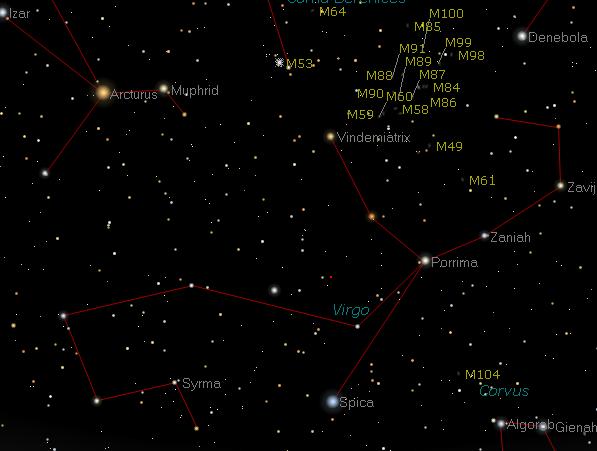
Coma:

This constellation is the first Decan of Virgo. A Decan is a lesser constellation that is associated with one of the Zodiac figures. To the ancients, the constellation Coma was connected with Virgo. Its original Hebrew name was Kamah or Comah meaning “the Desired, or Longed for.” The word is used in Psalm 63:1 where David said to God that “My soul longs for You.” The word is also associated with chemdah or “desire” which is used in Haggai 2:7 to speak of Messiah saying that “The Desire of all nations will come.” This interpretation is backed up by the Zodiac in the Egyptian Temple at Denderah where there is the figure of a woman and child representing Coma, but the Egyptian name for it was “Shes-nu” or “The Desired Son”. We can go further. Even Shakespeare knew of this signification for in Titus Andronicus Act iv Scene 3, he speaks of an arrow speeding heavenward to “the Good Boy in Virgo’s lap.”
The ancient Sumerian name for this constellation was HE.GAL- a-a. HE means "good," GAL means "great" and the a-a ending means "son."
The ancient Akkadian name for this constellation was kakkab nushi. Ka means "house;", nu means "king" or "lord;" and shi is "horn," "offspring" or "power."
Albumazar (or Abu Masher 787-885 AD) an Arabian astronomer to the Caliphs of Grenada about 850 AD said: “There arises in the first Decan [of Virgo], as the Persians, Chaldeans, and Egyptians … teach, a young woman, whose Persian name denotes a pure virgin sitting on a throne, nourishing an infant boy (the boy, I say) having a Hebrew name, by some nations called IHESU, with the signification IEZA, which in Greek is called CHRISTOS.” A Latin translation of Albumazer’s writings is in the Library of the British Museum. Thus there can be no doubt about Albumazer’s understanding of the star story. This is all the more interesting since he was a Muslim.
Nevertheless, this is NOT what is found on modern maps. Instead of Comah or Chemdah we now have Coma Berenices, or, literally, Berenice’s Hair! Berenice II was the battle-seasoned wife of Ptolemy III (Euergetes), king of Egypt in the 3rd Century BC. Ptolemy Euergetes embarked on the 3rd Syrian (or Laodicean) War, and left Berenice as head of government while he was away. She vowed to consecrate her magnificent hair to Aphrodite if he returned safely. Ptolemy III campaigned into Babylonia for five years until 241 BC and did return safely. His wife’s hair was duly hung in the Temple of Aphrodite. However, shortly after, the hair was stolen, and Conon, the court astronomer in Alexandria (283-222 BC) comforted Berenice by indicating that Jupiter had taken it and made it the constellation Coma Berenices! It may be that the deception was deliberate in this case. Conon knew very well that the constellation’s name was comah (desired) which was very similar to the Greek word “Có-me” or Latin “Coma” both of which mean “hair”. One may be excused for thinking that Conon was, at the very least, covering for the theft. Callimachus, who was the Historian of the Alexandrian Library at the time, made sure that this event was recorded that way on their star maps. So it is through these actions that we have a corrupted name today.
LIBRA, Centaurus and the Southern Cross
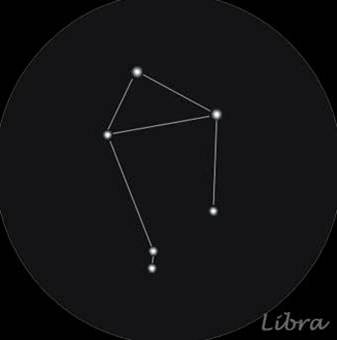
The original name of this constellation in the Akkadian language was Tul-Ku, meaning a sacred mound, or an altar. Akkadians believed that the souls of the deceased were weighed at God’s altar. The altar became synonymous with the idea of scales, where souls were weighed. The name for these particular scales was Zibanitu, or Zuben-itu. Because this Altar, Tul-Ku,was associated with Zuben-itu, the Balance, the two became connected in the Indian language so that the Indian words Tula or in Tamil (a southern Indian dialect), Tulam or Tolam, all mean “Balance” or “Scales”. In Hebrew the constellation is Moznayim or “Balance” as in Isaiah 40:12. The use of the prefix “Zuben” in some of the star names therefore comes from the ancient Akkadian language.
For this reason, the Alpha star (the furthest one to the right on the green lines in the diagram above), or Zuben el Genubi (or Ganabi) means “the balance/purchase/price is deficient.” It is also the root from which the Hebrew word “stolen” is derived.
The Beta star (the uppermost star) is Zuben el Chamali (or Shemali), meaning “the price which covers”, a word whose root comes into Hebrew as meaning “raiment” or “cloth.” The Hebrew name for this star was Kaphar which means “to cover” or “the atonement.”
The star Gamma (connected to the Beta star, coming down to the left) is Zuben Akrabi, meaning “the Price of the Conflict” or “the Price of the War.” This could be referring both to the battle with evil on the cross (the Southern Cross constellation is a Decan of Libra) as well as Armageddon itself. The possible reference to Armageddon can be drawn due to the fact that Scorpius, the scorpion is the next constellation in the zodiac. More about the scorpion later, but it is important to note that this constellation always represents ‘against Christ’ or ‘anti-Christ.’ The ancient Akkadians showed something interesting on both their seals and boundary stones. On these was a picture of the scorpion’s claws seizing the altar of Libra. In other words, they had combined the two pictures into one and called it the “Constellation of Claws.”
The delta star in Libra is Mulu-Izi, or “Man of Fire.”
In Revelation 13:13, we find the Antichrist calls down fire from heaven in the sight of men. This is similar to what Elijah did in the 8th century B.C. to conquer the priests of Baal. When he did this, Elijah was able to turn a remnant of the people back to the living god. Revelation tells us the Antichrist will do the same to cause most people to worship him. His evil rule is brought to an end at the Battle of Armageddon. This is the “price of the conflict.”
The price of the conflict, however, is also on the Cross, where the payment was made for our sins, and spiritual evil was thus conquered. So Libra, the sacred Altar and Balance, also shows that our lives fall short of God’s standard – the price is deficient – we are weighed in the balance and found wanting. But the Price that Covers is the atonement made by Messiah for all humanity, who paid the price by His conflict against evil and shed His blood to blot out our sins.
Associated with Libra is the constellation Centaurus, with the Southern Cross at its feet, or base.

The two bright stars on the lower left of the photo above are Alpha Centauri and Beta Centauri. They "point" the way to the southern cross, shown as "Crux" in the photograph below. The Southern Cross is in the middle of the photograph above.
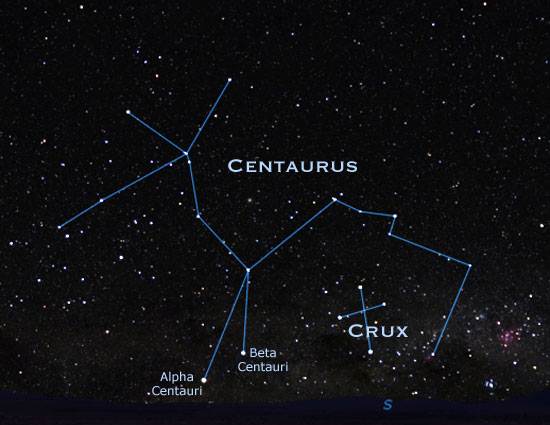
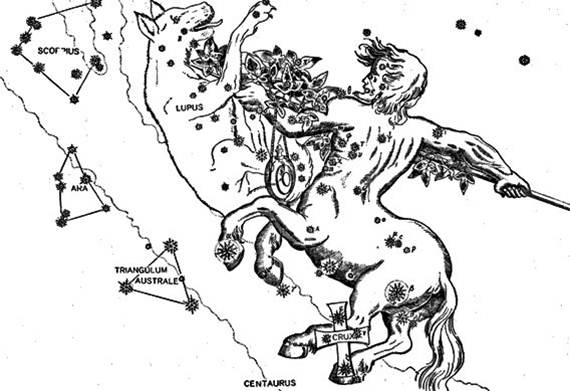
A Centaur is either a two-natured person, or a combination of a man and horse as a unit of war
The name of this constellation in Sumerian was EN.TE.NA.BAR.HUM; Habasiranu was the Akkadian name. Taking the Akkadian name apart, we get
ANU = “Head God”; “God of the sky and heavens”; the “One with power to Judge”
HABA = “come” or “comes” or “came”
SIR = “command” or “order”.
Altogether, "Comes to command, the Head God (or Judge)."
It is interesting to note that "Jamieson, in his Celestial Atlas published in 1822, says that the Arabic and Chaldean name for Centaurus was Bezeh. (Bezeh is also a Hebrew word which means 'the despised one.')" [D.E. Spencer, The Gospel in the Stars, from Word of Grace, San Antonio, Texas, 1972]
In Isaiah 53, the coming Messiah is spoken of as the Despised One.
Centaurus and Crux received ancient names because they were visible in the Northern Hemisphere 2000 years ago, although they are not now. This is because of the way the axis of the earth itself wobbles a bit.
SCORPIUS, Ophiuchus, Serpens, and Corona

The Scorpion’s tail portion was called Lesath in Hebrew or Lesha in Chaldean which means “Perverse One”. The brightest star in the Scorpion is Antares a form of Anti-Aries meaning “against the Lamb”. While it is true that this constellation is in the opposite part of the sky to Aries the Ram, the complete story is told by the surrounding constellations. The one who is “against the Lamb” is the “Perverse One”, the Antichrist who the Scriptures say will overturn the Altar in the newly constructed Temple in Jerusalem and cause all to worship him instead. The constellation behind the tail of the scorpion is Ara the overturned altar. The rest of the star-story shows the mighty man (or strong man) Ophiuchus restraining Serpens the Serpent from reaching Corona the Crown, and at the same time bringing his heel down on Antares the one who is “Against the Lamb”. The star in his heel is called Shuph or “Bruised” as in Gen. 3:15.
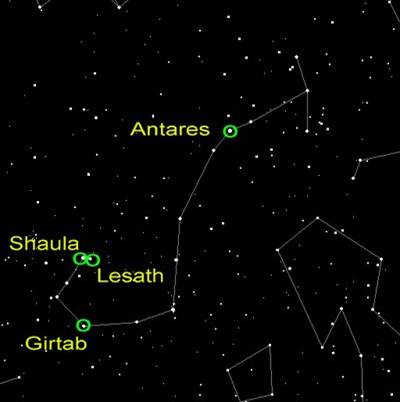
The Akkadians called Scorpio "Girtab," the "Seizer," or "Stinger," and "The Place Where One Bows Down." Today Girtab is the name of one of the stars in the tail. Another star in Scorpio is Shaula, which is the Arabic word for "raised tail."
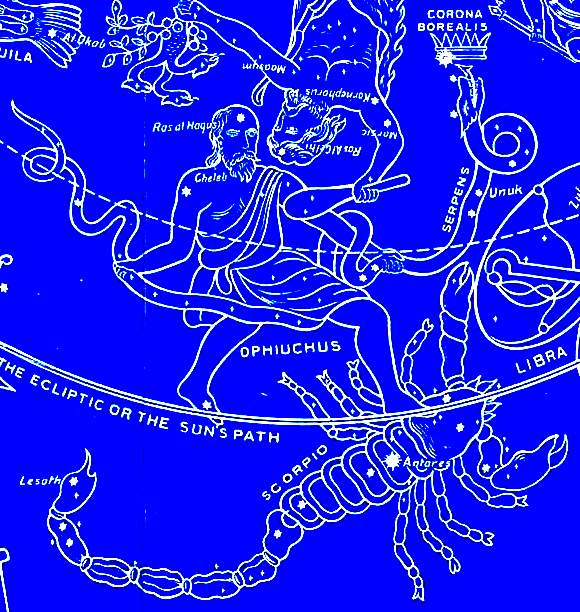
Ophiuchus restraining Serpens the Serpent from reaching Corona the Crown, and at the same time bringing his heel down on Antares
The biblical story connected to this series becomes rather obvious in the star names and what we see happening. In Genesis 3, God told Satan that the seed of the woman would bruise, or crush, his head. The fact that the scorpion has a tail helps explain visually how Satan could, in return, bruise the heel of the strong man, Christ.
SAGITTARIUS
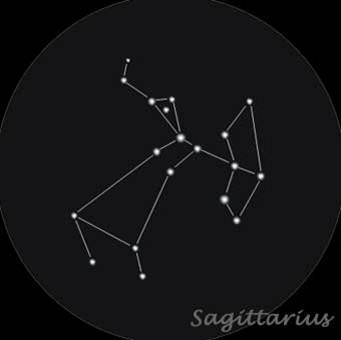
Aratus’ Poem
“Midst golden stars he stands in splendor now,
Piercing the Scorpion with his bended bow”
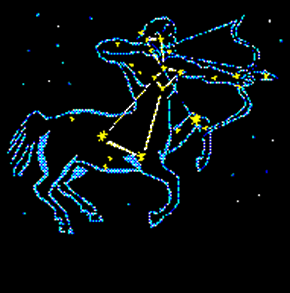
Sagittarius is depicted as a Centaur with a bow and arrow pointed towards Antares, the heart of the Scorpion. A Centaur, envisaged as half man half horse, represents a two-natured person. There was only one Person in existence who genuinely had two natures, both God and Man – Jesus Christ. He it is who will defeat the Antichrist (Anti-Aries = Antares against the Lamb) portrayed by the Scorpion and mentioned in Aratus’ poem.
Stars in this constellation include:
Kaus Australis – lower part of the bow
Nunki – meaning prince of the earth (Babylonian name, from Akkadian) – also called Sadira, meaning “prominent”
Terebellum, which means "earth war"
Kaus, meaning "bow"
Some point out that Centaurs were despised in Greek mythology – and Messiah was “despised and rejected of men” (Isaiah 53:3).
This constellation may also point to the future: Christ comes back to final battle against Antichrist riding on a white horse. He is the mighty prince who is destined to rule the earth.
That occurs after Scorpion (Antichrist) is killed in the final war.
CAPRICORN the "sea goat"
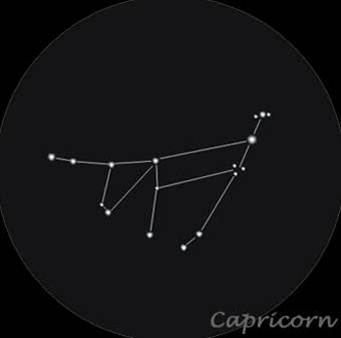
The Goat was a sacrifical animal. The sea is an almost universal picture of humanity. The brightest star in this constellation is actually a double star. It is Deneb Al Giedi – “the Judge who is the sacrifice.” The goat, in ancient Israel, had a double role to play. One was designated as a 'scape goat' who would vicarously carry the sins of the people into the wilderness. Another goat would be the sacrifice.
The Messiah was both: "Surely he took up our infirmities and carried our sorrows, yet we considered him stricken by God, smitten by him and afflicted. But he was pierced for our transgressions, he was crushed for our iniquities; the punishment that brought us peace was upon him, and by his wounds we are healed." (Isaiah 53:4-5)
In line with the picture presented in this constellation, as well as many passages in the Bible, Jesus referred to Himself as the 'son of man.' He was from humanity -- that's the fish part. He was the sacrifice -- that is the goat part. And, as the double star informs us, He is also the Judge as well as the Sacrifice.
It is interesting that an entire picture is drawn around this simple star grouping. However the picture has been with us for thousands of years -- a goat with a fish tail, or 'sea goat.' This 'sea goat' was a god in Sumeria. If the gospel in the stars had been known since at least the time of Noah, if not earlier, then the Sumerians were remembering a piece of the story and making a god out of the star group itself.
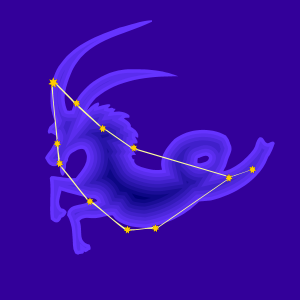
AQUARIUS and Pisces Austrinus
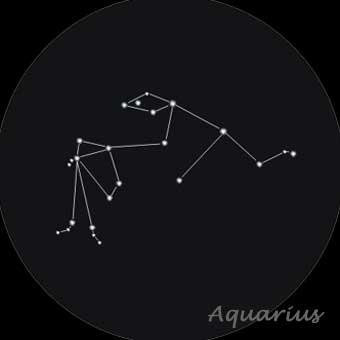
The Hebrews referred to Aquarius as Deli or “Water Buckets”. In other cultures the picture is shown with a two-handled water or wine jar, with the liquid contents being poured out down to Pisces Austrinus -- the southern fish. Acquarius is a very faint constellation, and we were not able to find any ancient star names associated with it. However, the Sumerian name for the constellation itself translates into "the great one."
In the Bible, the Hebrew word deli is used in Numbers 24:7 in the oracle of Baalam. “He shall pour the water out of his buckets and his seed shall be in many waters.” This identification seems to be made in the Beth Alpha Synagogue in Israel with the fascinating Mazzaroth (Zodiac) on the floor. There Aquarius is linked with Reuben. As the astral motif indicates a mighty man of stature pouring out the water, we note a parallel with the Son of God pouring out the rivers of living water. In the astral motif, the river flowing out of the urn is the source of life for Pisces Austrinus, the Southern Fish (Jn. 4:14; 7:38). The Lord spoke through Isaiah “I will pour water upon him that is thirsty, and floods upon the dry ground; and I will pour my Spirit upon your seed and my blessing on your offspring…” The star-story is then depicting the mighty God-Man, Jesus Christ, pouring out His Spirit so that those who believe on Him (the Fish) might live in the spiritual sense. The small constellation of Pisces Austrinus is dominated by the first magnitude star Fomalhaut which is Arabic for the “Mouth of the Fish”.

PISCES

In Hebrew this constellation is Dagim, the 'im' ending indicating a plural. Dagim means "fishes." The Syriac word, meaning the same thing, is Nunno. This constellation is also faint, and there are no known ancient star names. One of the two fish in the constellation is marked by a circle of stars.
Biblically, the two fish represent the two bodies, or assemblies, controlled by Christ: Israel being the earthly, or horizontal, fish and the body of believing Christians being the vertical fish. Together they represent both the earthly and spiritual bodies claimed by God.
The old star charts show the hoof of Aries the Ram resting on the band which binds the two fish together. This therefore indicates that there are two bodies or assemblies which the Lamb of God (Messiah) controls. Historically we know that this is the Children of Israel (the earthly or horizontal fish) and the Gentile believers (Church or vertical fish). Together they represent the earthly children and spiritual children of Messiah.
ARIES and Cetus
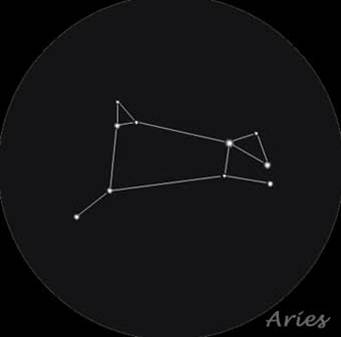
Aries is the ram, or the lamb. It is Taleh in Hebrew, which means "lamb." The brightest star is El Nath. "El" is a rather generic word and means "authority, god, or judge." "Nath" means "broken, or cut in pieces, or poured out."
1 Corinthians: 11:24 -- "this is my body which is broken for you..." Jesus is the Lamb of God; He is the authority, the God, the judge broken for us.
The star picture tells more of the story, however. The ram/lamb's forefoot is stretched out over the cords which bind the fish in Pisces to the beast, Cetus. Thus the ram is said to either be claiming the fish as his or cutting their bonds which attach them to the beast
Here is Cetus, the sea monster:
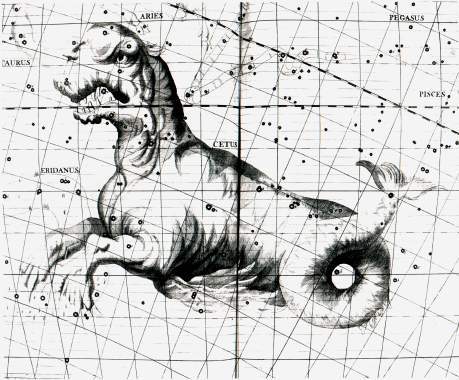
and here is the full picture, showing Aries breaking the bonds attaching the fish to the sea monster:

The brightest star in Aries, El Nath, is actually part of two different constellations. Because astronomers drew new pictures of the stars, (changing the constellation boundaries) El Nath is now on the tip of the horn of the Bull, and called “the butting” or “the butting one.” But the Hebrew name means something else and in the ancient star pictures, El Nath was part of Aries the Ram.
TAURUS, the Pleiades and the Hyades

The Hebrew word for bull or ox is “shur” which also means “to return” or “to come back”. The brightest star is Aldebaran which means “the follower”. The second brightest is El Nath. There are two distinct star groups in Taurus: the Hyades and the Pleiades. Hyades means “congregated” while Pleiades comes from the Hebrew for “gathering” and the Greek “Pleistos” or “Pleion” which means “The many”, “the excellent” or “the great”. The Japanese name for the Pleiades is Subaru, and the Persian name is Soraya. Ancient Greeks called them "the clusterers." The Bible sometimes refers to the Pleiades as the "seven stars" and sometimes to "Pleiades." They are mentioned in Job 9:9, 38:31-32; Amos 5:8; Rev.1:16, 20.
In Job it is the Pleiades, but in Revelation, Christ is holding the seven stars in His hand, representing the seven churches. Since the Hebrew word for the Pleiades comes from the root meaning "gathering," the meaning was inescapable for the early church. Seven gatherings -- seven churches. Christ used a star picture people knew and applied it to His Church.
So Christ gave us the main part of the Bible story in this constellation. However, remember that the word for "bull" is also the word for "return," and this is another important part of the story. We are almost to the end of the Zodiac, and the promise is there that Christ will return.
|
|
| The Pleiades, in the heart of the Bull, also known as the Seven Sisters |
The Hyades, a V shaped formation making up the eyes and nose of the Bull |
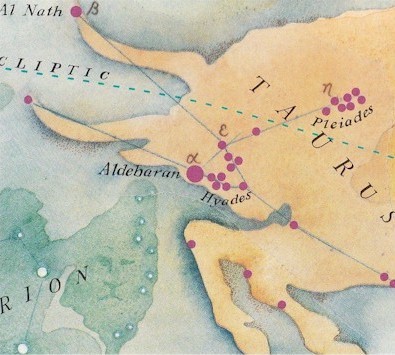
GEMINI

The Hebrew name for this constellation is Thaumim meaning “Joined Together” as in Exodus 26:24. The Romans called the twins Castor and Pollux which are now the names of the two brightest stars. These are the Latin equivalents of Hercules and Apollo from the Greeks, the mythical twin sons of Zeus, the supreme deity. Hercules was to labor and be the one who suffered while Apollo brought peace and intelligence to civilization.
The star in the left foot of one figure bears the name “Al Henah” which means “wounded” or “bruised.” The star in the right knee of the other figure and bears the name “Mebsuta” which means “ to trample underfoot, tread down (step on many times until flat).” Another star is called “Waset” or “Waseth” which means “appointed”.
The Bible tells us Christ comes twice: the firt time to labor and be wounded, or bruised. Then He returns to fight and vanquish His enemies. In the old Middle East cultures, the victor would either walk on or put his foot on the defeated enemy, thus 'treading him underfoot.' It was a sign of total victory. Here again, ancient legends and myths -- this time Greek and Roman -- hold sufficient remnants of the original truth for that truth to be discerned through the legend’s fog.
Isaiah 22:5 The LORD, the LORD Almighty, has a day of tumult and trampling and terror in the Valley of Vision (or “Zion”) -- the reference here is to Armageddon.

In Egyptian Zodiacs Cancer is represented as a Scarabeus Beetle. In Hebrew it is ‘Ash’ or Butterfly. To the Indians it was a Crab. Ancient Sumerians saw it as a Crayfish. In each case, the creature concerned rose to a new life out of its old shell. The brightest star is Acubene which is related to the Hebrew word for “hiding place.” This picture is reinforced by the Praesepe cluster. The word comes from Latin, means "a crib, a manger, a hive, or a fold for animals." In Job 38:32, God asked if Job could “Guide the constellation Ash (‘Butterfly’) with his ‘Multitude’ (‘Offspring’ or ‘Children’ or ‘Sons’)”. This refers to Cancer and the Praesepe cluster. It is all the more significant since Job had stated in his discussion in Job 19:25 “I know that my Redeemer Lives, and He will stand on the Earth in the Last Days. And though after death worms consume my body, yet in my flesh will I see God, whom my own eyes will behold, and not another’s.”
The name "Cancer" may be related to Arabic. In old Arabic this sign was “Khan Ker” which means "priest-prince."
The meanings of the name of the constellation itself and the associated stars may have to do with the Priest-Prince being our hiding place

The Praesepe open cluster in Cancer - 350 stars
LEO the Lion, HYDRA the Serpent, CORVUS the Crow and CRATER the Cup.

Leo the Lion was the banner or standard for the tribe of Judah (Numbers 2:2-3; 24:9 compared with Genesis 37:9; 49:8-12). Brightest star is Regulus. Word Regel/Regal/Ragal is the Hebrew or Chaldean word for “foot.” So Regulus literally means to “tread under foot”. Because kings did this to their enemies the word became associated with royalty. The second brightest star is Denebola. In Arabic is means "tail of the lion." But Dan/Den/Din is the Hebrew root for “Judge,” and bo is "to come," so it is possible that Denobla means “The Coming Judge”. The next brightest star is named Algeiba (Arabic) or El Gibbor in Hebrew which means “The mighty God-man.” Isaiah 9 – “And He will be called Wonderful Counselor, Mighty God (El Gibbor), Everlasting Father, Prince of Peace….” The name for another star is Zosma. Because this has many variants nothing certain about its meaning can be said.
So the story ends with the victorious Lion of Judah, the Mighty God-Man, the Coming Judge who will Tread Under Foot the enemy. Leo is “treading under foot” the Fleeing Serpent, Hydra, that Old Serpent, whose brightest star is Alphard “the Accursed One”. When that happens, Corvus the crow and the other raptors are called to the battle of the great Day of God at Armageddon where they feed on the flesh of the armies. This is the day when the Cup of God’s Wrath is outpoured, which is the significance of the constellation Crater the Cup.
 (2).jpg)
Even the ancient Egyptians knew the story:

SOME OTHER CONSTELLATIONS
PERSEUS
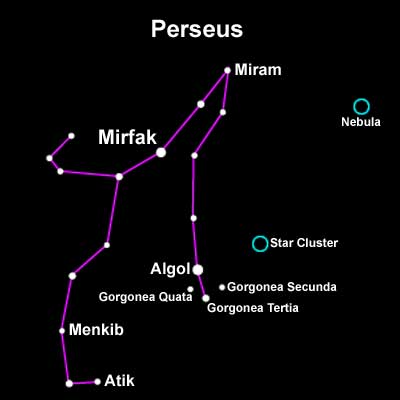
In Hebrew, this constellation is Peretz or Parats which is in Greek Perses and Latin Perseus. The Hebrew means “Breaker” or “Deliverer” or “the One who Breaks Open the Way”as in Micah 2:12, 13. There Messiah gathers the remnant of Israel and breaks open the way as their LORD. The star Omicron concurs as it is named Atik or Attiq in Hebrew meaning “Ancient One”. In Daniel 7 this word is used to describe “The Ancient of Days”. The star Zeta is Menkib or Markab which means “something to ride upon.” Daniel 7 pictures this conveyance as the Shekinah Glory Cloud. The star Alpha is called Mirfak or Mirzak (Javelin), with Beta being called Al Ghoul, the Evil One, whose head is pictured as decapitated. So Messiah, the Ancient of Days (Micah 5:2), comes on the Shekinah at the end of the Age to break open the way and deliver us from the Evil One.
AURIGA
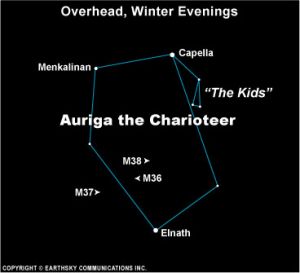
Auriga is usually called the “Charioteer” in modern astronomy. This name has come to be attached to this constellation as a result of the poem about the stars by the Greek writer from Tarsus called Aratus. In his poem he speaks of Auriga “urging on his tardy wain”. However, the star names do not bear out this image that Aratus has given to us. To begin there is the asterism called the “Haedi” or “the Kids”, and the word Capella is from the Latin for “she goat”. In fact the word Auriga is derived from the Hebrew “or” or “aor” meaning “light” and the word “raah” which means “shepherd” or “friend”. Thus “Aor-raah” which gives us Auriga means “The Shepherd of Light”. The star Epsilon bears the name “Al Maaz” which is Hebrew for “The Despised or the Rejected One.” This word is used of the LORD in Numbers 11:20. The second magnitude star Beta Tauri used to be Gamma Aurigae until constellation boundaries were fixed about a century ago. That star is named “El Nath” which comes from the Hebrew “Nathach” or “Natak” or “Natha” which means “broken” or “poured out”. "El" is the generic word for "god, authority, judge." Finally the star Beta is called “Menkilinon” or “Menkalion”. This comes from two Hebrew words “Men” meaning a “number” and “Killayon” which means “Consumed” as in Isaiah 10:22, 23. Thus the story is of the Despised or rejected One who is the Shepherd of Light, who poured Himself out to protect the Kids while the unprotected number outside are consumed. It is of interest to note that the Shepherd is usually shown protecting two Kids – the two groups that belong to Messiah – Israel & the Church.
THERE ARE THREE FIRST MAGNITUDE STARS THAT FORM THE “SUMMER TRIANGLE”. They are Vega in Lyra the Harp, Deneb in Cygnus the Swan, and Altair in Aquila the Eagle.
1. LYRA - The Harp
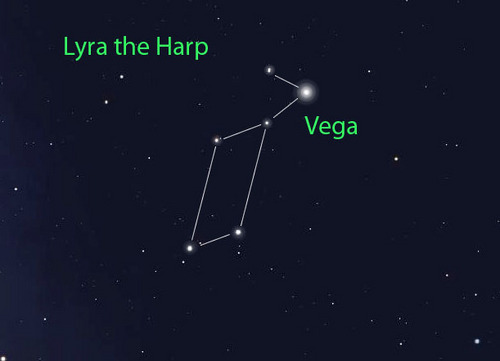
The brightest star, Vega, means “Fallen Star,” and as such refers to Lucifer who fell from Heaven and became Satan the Adversary. Lucifer was one of the highest created angels, and was at least the guardian cherub of Eden, and possibly of the entire world. (See our study on Ezekiel 28). There is a strong identification with music in this Ezekiel passage. This is the connection with the Harp. He fell from heaven due to his pride as outlined in Isaiah 14:12 ff.). In Babylonian astronomy, Vega was identified with the “Messenger of Light” in accord with the status of Satan in 2 Corinthians 11:14. The word "Lucifer" means "light carrier." In Akkadian, Vega was called the “Life of Heaven”, and in Assyrian “The Judge of Heaven” as having the highest position next to God. All told, this star has had some 40 names associated with these connotations. The the second-brightest star has the name Sheliak which derived from an ancient name for a harp. This picks up the music in heaven idea from Ezekiel.
2. CYGNUS, The Swan
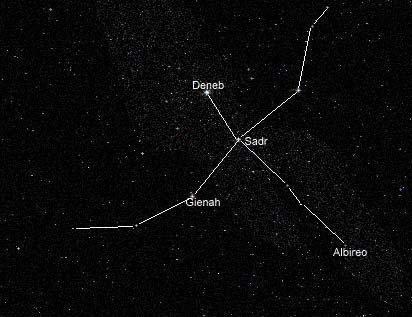
This is one of the most conspicuous constellations in the Northern Hemisphere, immersed in the Milky Way, with a binocular feast of star-fields and 30 open clusters. Cygnus is basically in the form of a Cross. The brightest star, Deneb, has the Hebrew root of Dan, Den, or Din which means Judge. The second-brightest star is called Albireo which means “Sacred Father”. The Greek word “Ieros” meaning “sacred” carries through this idea.
Isaiah 9:6 calls Messiah the ‘Everlasting Father’ and the Scriptures affirm that he is also the Judge to whom mankind will eventually answer.
3. AQUILA –The Eagle
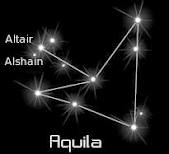
A fine constellation that straddles the Milky Way and the Celestial Equator. The brightest star, Altair is an intense white star of 1st magnitude that contrasts with its 3rd magnitude orange neighbor Tarazed and 4th magnitude Alshain. In Arabic Al Tair means “the Flyer”. In Persian At Tara means “the Star” while in Hebrew El Tara literally means “the Carrier of God”. the second brightest star in this constellation is named Alshain from the Hebrew “Shani” which means “ Scarlet” and hence came to mean “Blood”. The third brightest star is Tarazed which means “Carrier of Strength” from the Hebrew Tara (carrier) and Zed meaning “strong” or “strength”. Thus Aquila the eagle represents the Shekinah which is the “carrier of God” and which specifically included the 4 Cherubim who each had one of their faces in the form of an eagle in Ezekiel 1 and Revelation 4. Daniel 7 also reveals that it is Messiah who comes in the Shekinah and He was the one who shed His blood as a sacrifice.
URSA MAJOR – Great Bear/Flock/Fold.
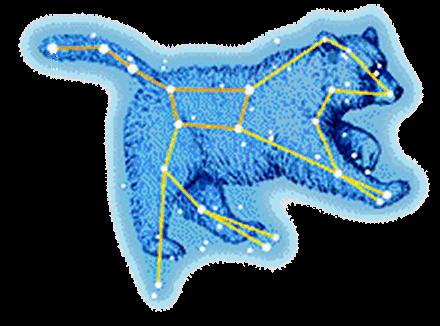
Here we have a mix-up because of Aratus’ poem. Alpha in Ursa Major is called Dubhe in Hebrew or Dubah (Arabic) both of which mean fold or flock. The word ‘fold’ implies rest and security and strength as a sheep would find in a sheep-fold. The word is used this way in Deuteronomy 33:25 to describe our strength or security from the Lord. It must now be noted that Dubhe or Dubah has been confused by Aratus with the Hebrew ‘dohv’ or Arabic ‘dub’or Persian ‘deeb’ all of which mean bear. They are pronounced almost the same way and in some concordances the words are consecutive. However, they have vastly different meanings. Because of this linguistic mix-up, we now have the Greater and Lesser Bear instead of the Greater and Lesser flocks or folds. You can see the "Big Dipper" in orange in the picture above. That is one star group that is very easily recognized by most people.
BOOTES
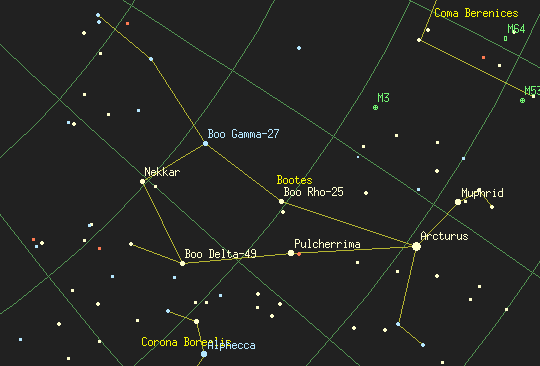
This name for the constellation originally derives from the Hebrew root bo and Egyptian bau both of which mean “The Coming One”. The brightest star, Arcturus has its name from the poem by Aratus (Greek). It literally means “guarding the bear” from its position behind Ursa Major. The ancient Hebrew name for this star has been preserved in the book of Job and was Auwsh meaning “To Hasten”. The second brightest star is called Nekkar or “pierced one”. The third brightest star is a fine double -- one is pale orange and the other is blue-green. Together they are called Izar (from the Yiddish Issur) which means “Prince with God”.
HERCULES - the kneeling man

Note that Hercules has his foot on Draco, the dragon, in triumph over it.
The brightest star in Hercules is called Ras Algethi, Arabic for “The Kneeler’s Head”. Another star is called Sarin from Saris, the Hebrew word for “Officer” or “Minister of State.” The Chaldean word sarek means “President”or “Lord”.
One star has the name Maasym, which is Hebrew for “Despised One”. Still another star is Kajam from the Akkadian kittam meaning “justice”.
In this final story presented here, we have the Despised One triumphing over Draco, the dragon, and who is President, or Lord, and who will bring justice to the Earth.
|